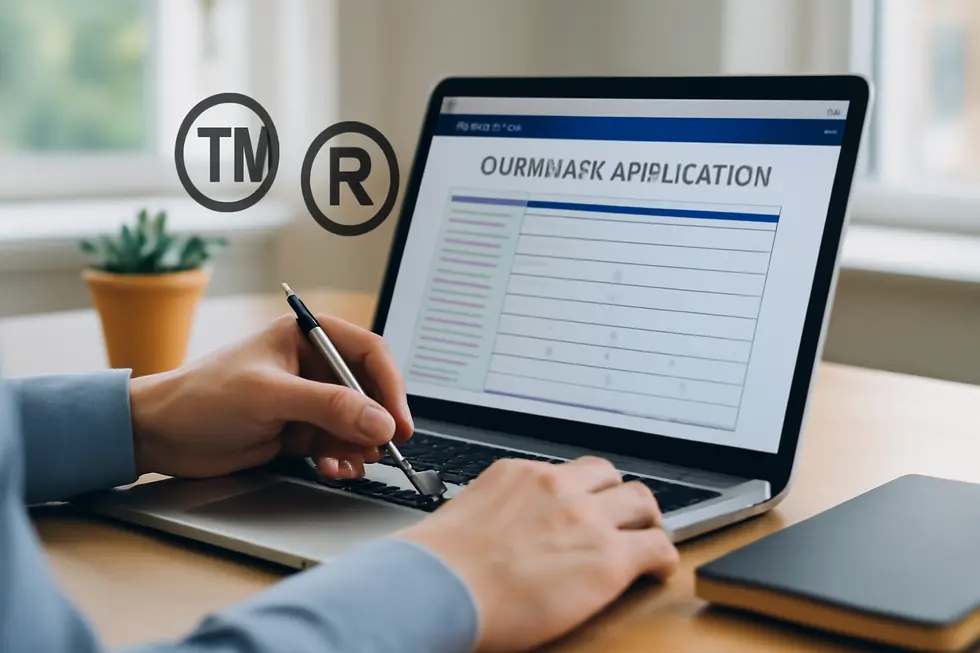Introduction
Choosing a name for your business is a crucial step in establishing your brand identity. However, many business owners mistakenly believe that copyright law can protect that name. This misconception can lead to costly setbacks because copyright does not extend to business names. Instead, trademark registration provides the legal framework to safeguard your business name from unauthorized use and confusion in the marketplace. This article explores why copyright cannot protect business names, walks you through the trademark registration process, and clarifies your rights and responsibilities after securing a trademark. Understanding these distinct protections ensures you can confidently defend and cultivate your brand.
Tables of Contents
Chapter 1: Understanding Why You Cannot Copyright a Name for a Business
- Decoding Intellectual Property: Why Business Names Fall Under Trademark, Not Copyright
- How Trademark Law Safeguards Business Names and Drives Commercial Value
- Navigating Trademark Registration: The Essential Legal Path to Protect Your Business Name
Chapter 2: The Process of Trademark Registration to Protect a Business Name
- Navigating Trademark Registration: Key Steps from Application to Federal Protection
- Navigating Trademark Registration: Legal Authority and Economic Advantages in Securing Your Business Name
- Leveraging Digital Tools and Understanding Timelines for Seamless Trademark Registration and Vigilance
Chapter 3: Legal Rights and Obligations After Trademarking a Business Name
- Harnessing Exclusive Trademark Rights: Obligations and Strategies for Brand Protection
- Sustaining Trademark Rights: Essential Use, Renewal, and Vigilance Requirements
- Understanding Legal Risks and Protections Beyond Business Name Registration in Trademarking
Chapter 1: Understanding Why You Cannot Copyright a Name for a Business

1. Decoding Intellectual Property: Why Business Names Fall Under Trademark, Not Copyright
Copyright law fundamentally protects original expressions such as books, music, artworks, and other creative works. It grants creators exclusive rights over reproduction, distribution, and adaptation of their original content. However, this protection does not extend to business names, which are considered identifiers rather than creative expressions. A business name primarily functions as a source identifier, distinguishing your goods or services in the marketplace. This crucial difference places business names under the realm of trademark law instead of copyright.
Trademark law safeguards marks—such as business names, logos, and slogans—that serve to identify and distinguish products and services. The primary goal is to prevent consumer confusion and unfair competition by granting businesses exclusive rights to use distinctive marks connected to their offerings. Unlike copyright, which protects creative content indiscriminately of commercial use, trademark protection requires that the name be actively used in commerce related to the specific goods or services.
Because business names are not considered creative works, you cannot claim exclusive copyright rights over them. Protection comes through registering your business name as a trademark with the U.S. Patent and Trademark Office. This registration provides nationwide legal rights and allows you to use the ® symbol, informing others of your exclusive claim. Without a registered trademark, others may use your business name without violating copyright law, which does not cover names or titles.
The legal distinction underscores the specialized purposes behind each form of intellectual property. Copyright safeguards the creative expression itself, while trademark law secures brand identity and market clarity. Understanding this difference directs business owners toward the correct legal path for protecting their names and brands.
For further insights on how trademarks specifically protect businesses, you can explore the article on brand and trademark protection. Additional detailed guidance is available through resources like LegalZoom’s analysis of trademarks versus business names.
2. How Trademark Law Safeguards Business Names and Drives Commercial Value
Copyright law protects original creative expressions such as books, music, and artwork — not business names, slogans, or short phrases. These brand identifiers fall under trademark law, which serves a vital economic and commercial function by safeguarding the unique identity of a business in the marketplace. Trademarks ensure that consumers can reliably associate a name or logo with a specific source of goods or services, preventing confusion that could arise from similar or identical marks used by competitors.
Unlike copyrights that attach automatically upon creation, trademarks require active use in commerce and often registration through authorities like the U.S. Patent and Trademark Office to secure robust legal protections. This official registration empowers a company with exclusive nationwide rights to its business name within specified categories, allowing it to enforce those rights in court and prevent brand dilution. Protecting business names through trademarks encourages companies to invest in building strong, recognizable brands—assets that hold considerable economic value and foster customer loyalty.
Relying solely on copyright protections for a business name would leave a brand vulnerable to imitation, as copyright does not cover names or short phrases. Trademark law fills this critical gap, focusing on identifiers that distinguish a company’s offerings rather than on creative expression. This distinction underpins how businesses protect their intangible assets, maintain competitive advantage, and support economic growth.
For further insights into how trademarks protect your brand and business identity effectively, you can visit this detailed resource on the benefits of brand trademark protection: brand trademark business protection.
Additionally, a comprehensive explanation comparing copyright and trademark protections is available from Cover Your Assets Online.
3. Navigating Trademark Registration: The Essential Legal Path to Protect Your Business Name
While it may seem intuitive to protect your business name under copyright law, this legal avenue does not apply. Copyright safeguards original creative works such as literature, music, or art, but it explicitly excludes names, titles, and short phrases. Instead, the appropriate legal framework to protect a business name is trademark law, which is designed to protect brand identifiers that distinguish a company’s goods or services in the marketplace.
Registering your business name with state authorities—like forming an LLC or corporation—provides official recognition and meets regulatory or tax requirements but does not grant exclusive rights to the name. This means another business can legally register and use the same or a very similar name in the same or other states. To secure exclusive use and prevent others from capitalizing on your brand, pursuing trademark registration at the federal level is essential.
Trademark registration is a formal process conducted through the United States Patent and Trademark Office (USPTO). It grants the registrant nationwide rights to the name within the specified goods or services category. To succeed, your business name must be distinctive and not confusingly similar to existing trademarks, since generic or merely descriptive terms usually cannot be trademarked. Unique marks that signify your brand identity are eligible to receive this protection.
Federal trademark registration confers several legal advantages, including the right to use the ® symbol, nationwide enforcement against infringement, and the ability to sue competitors who misuse your mark. Unlike state business registration, federal trademark protection holds legal weight across the entire country, underpinning the security of your brand.
The registration procedure involves first conducting a comprehensive trademark search to avoid conflicts, followed by submitting an application with the correct classification and use evidence. Maintaining trademark rights requires ongoing use in commerce and periodic renewals every ten years, reinforcing your exclusive claim.
For detailed guidance on trademark registration and legal protections, visit resources like this explanation on trademarking your business name.
Chapter 2: The Process of Trademark Registration to Protect a Business Name

1. Navigating Trademark Registration: Key Steps from Application to Federal Protection
Registering a business name as a trademark secures exclusive legal rights and shields your brand from imitators. This process begins with a thorough trademark search to identify any existing marks that might conflict with your desired name. Conducting this search upfront reduces the risk of application rejection and costly disputes later.
Once confident your business name is unique, you submit a detailed application through the USPTO’s online system, specifying the exact goods or services your mark will cover. Precise classification is critical, as trademark protection applies within the selected business categories.
Following submission, a USPTO examining attorney evaluates your application. This review ensures all legal requirements are met and that your business name does not infringe upon previously registered trademarks. This examination stage usually takes about three to four months.
If preliminarily approved, the mark is published in the Official Gazette, a public record that opens a 30-day window for third parties to file oppositions if they believe your trademark conflicts with theirs. Successfully surviving this opposition period moves your application closer to final registration.
Depending on the basis of your application—whether you already use the mark in commerce or intend to use it later—you may need to submit additional proof, known as a statement of use, verifying the mark’s commercial application.
Completing these steps culminates in federal registration, granting you nationwide exclusive rights to use your business name within the registered categories. This legal shield empowers your brand and strengthens your market position.
Because trademark rights require ongoing use and maintenance, periodic renewal filings every ten years are necessary to keep your registration active and enforceable.
For a comprehensive guide on filing procedures, fees, and legal considerations, visit the USPTO’s official resource on the trademark process USPTO Trademark Process Overview.
Additional insights on securing your brand through trademark can be found at how to trademark your business name.
2. Navigating Trademark Registration: Legal Authority and Economic Advantages in Securing Your Business Name
Registering a trademark to protect a business name is a legally strategic and economically advantageous process that offers exclusive rights and long-term brand security. Unlike unregistered common law trademark rights, which offer limited protection only within a local geography, federally registering a trademark with the United States Patent and Trademark Office (USPTO) grants nationwide priority. This exclusive right empowers the business owner to prevent others from using a confusingly similar name or mark in commerce, mitigating risks of consumer confusion and unfair competition. The registration also provides a solid foundation to enforce these rights through legal channels, including lawsuits for infringement and customs actions to stop counterfeit goods.
The trademark registration process itself begins with a thorough search to confirm the business name’s uniqueness in its specific market category. This step helps avoid clashes with existing trademarks that could delay or prevent registration. Once confident, the application is submitted online to the USPTO, incurring a fee generally around $350. An examining attorney reviews the filing for compliance with legal standards and conflicts before the mark is published publicly in the Official Gazette, allowing a 30-day opposition period. If no objections arise or are successfully addressed, the USPTO issues a registration certificate, confirming federal protection.
Economically, a registered trademark significantly enhances brand equity by legally safeguarding the goodwill tied to the business name. This protection not only deters unauthorized use, which can dilute brand reputation, but also unlocks opportunities for licensing and franchising—powerful avenues for revenue generation and market expansion. Maintaining the trademark through consistent use and periodic renewal fortifies this intangible asset over time, making it a core component of business growth strategy.
Ultimately, trademark registration unites legal safeguards with economic incentives, ensuring your business name remains a protected and valuable asset. For expansive guidance on the registration journey and its business benefits, consulting authoritative resources such as the USPTO is essential. Additional insights can be found at brand trademark business protection.
3. Leveraging Digital Tools and Understanding Timelines for Seamless Trademark Registration and Vigilance
The journey to securing trademark protection for a business name is supported heavily by advanced technological platforms that streamline the filing, examination, and monitoring stages. Before initiating an application, conducting a comprehensive trademark search is crucial to confirm the name’s availability and avoid conflicts with existing marks. This typically involves querying the USPTO database to identify any confusingly similar trademarks. Once verified, the application is submitted electronically via the USPTO’s Trademark Electronic Application System (TEAS), an efficient digital portal designed to handle federal trademark filings in the U.S. Applicants must indicate whether the trademark is already in use in commerce or if there is an intent to use it, which influences subsequent procedural steps and fees. The filing fee generally hovers around $350 per class of goods or services identified in the application.
Following submission, USPTO examiners review the application for compliance and conflicts. If deemed acceptable, the mark is published in the Official Gazette, inviting third parties to oppose it if needed. The entire registration process commonly takes between 8 to 18 months, a timeframe influenced by potential objections and the thoroughness of submitted documentation.
To further protect the brand beyond registration, ongoing monitoring is essential. Trademark management software allows businesses to track registration status, spot unauthorized usage, and manage renewal deadlines—registrations must be renewed approximately every decade. For businesses active in digital marketplaces, possessing a registered trademark unlocks access to specialized brand registry programs, which provide enforcement tools to combat infringement online. These platforms require detailed brand verification and offer unique protections tailored to e-commerce environments, solidifying the brand’s presence across physical and digital channels.
Harnessing these technological solutions simplifies navigating complex trademark procedures and ensures vigilant protection of a business name. For practical guidance on trademarking your brand, consulting detailed resources such as the USPTO Trademark Electronic Application System (TEAS) is invaluable.
For a deeper understanding of trademark protection and its vital role in brand security, see this comprehensive guide on trademark business protection.
Chapter 3: Legal Rights and Obligations After Trademarking a Business Name

1. Harnessing Exclusive Trademark Rights: Obligations and Strategies for Brand Protection
Once a business name is successfully trademarked, the owner obtains exclusive nationwide rights to use the name for the specific goods or services registered. This exclusivity is vital, as it enables the trademark holder to prevent competitors from adopting confusingly similar names in the same market, thereby preserving brand identity and consumer recognition. However, these rights come with a responsibility: the trademark owner must actively enforce and maintain their trademark to retain its strength and legal protections.
Active enforcement begins with vigilant monitoring of the marketplace and new trademark filings to identify potential infringements early. When unauthorized uses arise, prompt action—such as issuing cease-and-desist letters—helps deter further violations and signals commitment to the mark. Should informal efforts fail, the owner may need to initiate federal lawsuits to secure injunctions, damages, or removal of infringing parties, reinforcing their rights under the Lanham Act.
Additionally, enforcement can extend to border controls to prevent the importation of counterfeit goods bearing the trademark, protecting both the brand’s reputation and consumers. Trademark owners can also participate in opposition or cancellation proceedings against conflicting trademarks to maintain a clear and distinct brand presence.
Internally, educating employees about correct trademark usage is crucial to avoid unauthorized or inconsistent use that could dilute the mark’s distinctiveness. Maintaining active commercial use and timely renewal of the trademark registration every ten years are also essential to preserving its legal force.
Federal trademark registration offers clear benefits, including legal presumptions of validity, potential incontestability after five years, and the right to display the ® symbol, signaling ownership and deterring infringement. These advantages depend on persistent vigilance and proactive defense strategies.
For comprehensive insights on trademark rights and enforcement, resources such as LegalZoom’s guide on trademark rights and enforcement provide valuable details, complemented by scholarly summaries outlining federal trademark benefits and obligations.
2. Sustaining Trademark Rights: Essential Use, Renewal, and Vigilance Requirements
Securing a trademark for your business name is only the beginning of legal protection. To preserve exclusive rights, continuous diligence and timely maintenance are mandatory. Trademark law requires the owner to actively use the mark in commerce — it must remain consistent with the registered form and linked to the designated goods or services. Ceasing use risks abandonment, leading to loss of protection.
In the United States, this sustained use must be evidenced through periodic maintenance filings to the USPTO. Between the fifth and sixth year following registration, you must file a Section 8 declaration confirming continued use or explain valid reasons for nonuse, accompanied by specimens demonstrating the mark in commerce. This process then repeats every ten years, where Section 8 declarations are submitted alongside Section 9 renewal applications. Meeting these deadlines is critical; failure to file within the allowed window—typically one year before to six months after expiration—can result in cancellation of the registration, regardless of actual use.
Beyond administrative upkeep, trademark owners bear the responsibility of monitoring the marketplace. Vigilant enforcement against potential infringement preserves the mark’s distinctiveness and prevents dilution. Ignoring unauthorized uses can jeopardize your trademark’s strength or result in legal challenges that undermine your rights.
Furthermore, protecting your trademark from turning generic is essential. Use the trademark as an adjective followed by the product or service it represents and educate consumers on proper usage. This practice safeguards the unique identity your trademark confers.
Through continual use, timely renewal filings, active enforcement, and protection against genericide, a trademark owner sustains the full scope of exclusive legal rights. These obligations form the cornerstone of maintaining a trademark’s value and legal force beyond initial registration. For more details on trademark use and protection, consult this resource on legally protected brand trademarks and guidance from the USPTO maintenance and renewal requirements.
3. Understanding Legal Risks and Protections Beyond Business Name Registration in Trademarking
Legal Risks and Protections Beyond Business Name Registration in Trademarking
Registering a business name and trademarking it are fundamentally different legal actions with distinct implications. While business name registration usually occurs at the state or local level to ensure your entity’s name is on record, this offers limited protection. It does not grant exclusive rights or prevent others from using identical or confusingly similar names outside the jurisdiction. On the other hand, trademark registration provides stronger, enforceable rights nationwide, enabling you to protect your brand from unauthorized use.
Even after securing a federal trademark, challenges endure. One major issue is navigating infringement claims and opposition. Third parties may oppose your application during the trademark process if they perceive your name infringes on their existing rights. Moreover, infringement disputes can arise post-registration if your mark closely resembles an established trademark, as seen in cases protecting brand reputation even without direct marketplace competition.
Trademark protection involves ongoing obligations. You must actively use the mark in commerce and monitor for potential infringements. Ownership disputes can also occur, particularly if agreements do not clearly define rights or if former partners claim rights to the name. Such conflicts highlight the importance of well-drafted contracts and thorough due diligence.
Because trademark laws differ regionally, businesses should conduct comprehensive searches and seek legal counsel before registering. This reduces infringement risks and legal battles down the line. While business name registration is a necessary administrative step, trademark registration is the true tool for securing exclusive brand identity and combating infringement effectively.
For further insights on protecting your brand with trademarks and avoiding legal pitfalls, consult expert resources such as legally protected brand trademarks. For authoritative procedures and oppositions, the official United States Patent and Trademark Office website offers extensive guidance: https://www.uspto.gov/trademarks.
Final thoughts
Protecting your business name is foundational to building a recognizable, respected brand. While copyright law does not extend its shield to business names, trademarks offer the precise legal mechanism to secure exclusive rights and prevent imitation. Understanding the clear difference between copyright and trademark empowers business owners to take the correct steps in safeguarding their brand identity. By navigating the trademark registration process with diligence and fulfilling post-registration obligations, you can establish strong, enforceable legal protection that supports your business’s growth and reputation in the marketplace. Prioritize trademark protection—your business name is one of your most valuable assets.
Get your trademark today! Thousands have protected their brand by filing a trademark. What are you waiting for? Start your trademark application!
About us
The globe’s top website for registering trademarks and safeguarding your brand, name, logo, or slogan. We provide clear guidance, quick application services, and expert support to help business owners secure their intellectual property rights efficiently and confidently.







